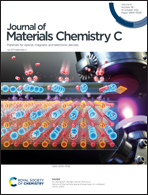Synthesis and molecular properties of isomeric thienoisoindigo†
Abstract
Three isomers of thienoisoindigo (TII) are prepared by changing the ring-fusion mode or the amide arrangement of lactam units, namely, 5,10-dihexyl-5,10-dihydrodithieno[3,2-c:3′,2′-h][2,6]naphthyridine-4,9-dione (TVTDA), 4,10-dihexyldithieno[3,2-c:3′,2′-h][1,6]naphthyridine-5,9(4H,10H)-dione (isoTVTDA) and (Z)-4-hexyl-6-(5-hexyl-4-oxo-4,5-dihydro-6H-thieno[2,3-c]pyrrol-6-ylidene)-4,6-dihydro-5H-thieno[3,2-b]pyrrol-5-one (isoTII). The differences in electronic structures are validated through theoretical calculations and photophysical and electrochemical analyses. It is found that both six-membered lactams (TVTDA and isoTVTDA) show strong fluorescence. By contrast, both five-membered lactams (TII and isoTII) show almost no fluorescence due to non-radiative deactivation through conical intersection. Then, thioanisole was selected as an anchoring group to estimate the charge-transport properties of the four isomers. Compared with lactams in a head-to-tail arrangement, lactams in a tail-to-tail arrangement have a greater conductance due to higher conjugation and bigger transmission probability. As a conclusion, variation of the amide arrangement of lactam units can significantly regulate the single-molecule conductance.



 Please wait while we load your content...
Please wait while we load your content...